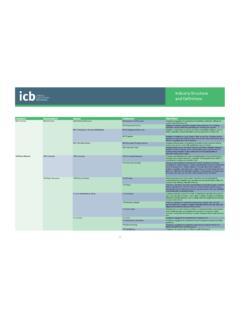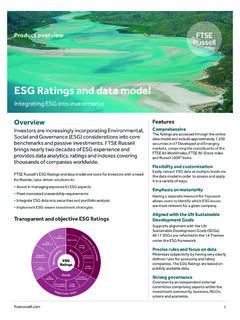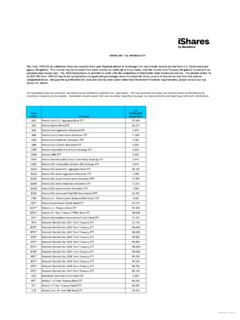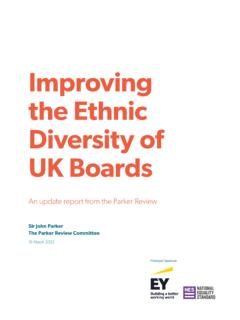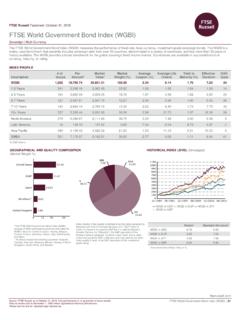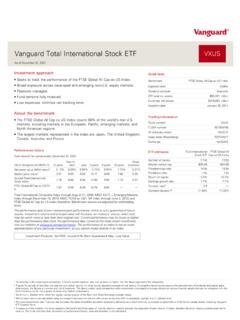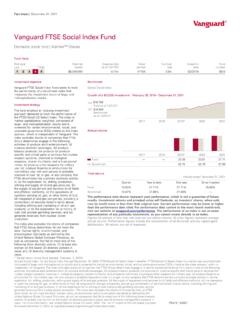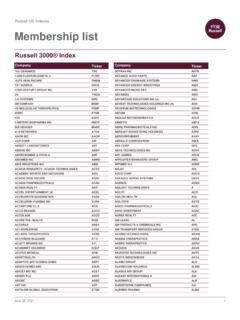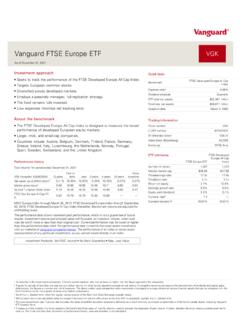Transcription of Guide to FTSE Sustainable Investment Data ... - FTSE Russell
1 Methodology An LSEG Business June 2021 Guide to ftse Sustainable Investment data used in ftse Indexes ftse Russell An LSEG Business | Guide to ftse Sustainable Investment data used in ftse Indexes, , June 2021 2 of 30 Contents Introduction .. 3 Overview .. 4 ESG data Sources .. 15 ftse ESG Ratings Quality Control .. 20 Transition Pathway Initiative Management Quality Score .. 21 The ftse Green Revenues data Model .. 22 The ftse Carbon Reserves data Model .. 25 The ftse Carbon Emissions data Model .. 27 Appendix A: Further Information.
2 30 ftse Russell An LSEG Business | Guide to ftse Sustainable Investment data used in ftse Indexes, , June 2021 3 of 30 Section 1 Introduction Introduction This document provides details of the Sustainable Investment data used in the construction and maintenance of ftse Sustainable Investment indexes which has been sourced by ftse Russell . ftse Russell ftse Russell is a trading name of ftse International Limited, Frank Russell Company, ftse Global Debt Capital Markets Limited (and its subsidiaries ftse Global Debt Capital Markets Inc. and MTSNext Limited), Mergent, Inc.
3 , ftse Fixed Income LLC, The Yield Book Inc and Beyond Ratings. No liability whether as a result of negligence or otherwise is accepted by ftse Russell (or any person concerned with the preparation or publication of this Guide ) for any losses, damages, claims and expenses suffered by any person as a result of: any reliance on this Guide , and/or any errors or inaccuracies in this Guide , and/or any non-application or misapplication of the policies or procedures described in this Guide . ftse Russell An LSEG Business | Guide to ftse Sustainable Investment data used in ftse Indexes, , June 2021 4 of 30 Section 2 ftse ESG Ratings Calculation Overview ftse Russell s ESG data Model produces ratings that are an objective measure of ESG exposure and performance in multiple dimensions (the ftse ESG Ratings).
4 The ftse ESG Ratings are used in certain ftse Sustainable Investment indexes to determine the eligibility of index constituents. Key Features Materiality: Exposure relative scoring at Theme level: It is important that companies that are more exposed to particular Themes such as Climate Change, Corporate Governance, and Labor Standards are doing more to address them. Therefore, higher exposure companies are assessed using higher thresholds than lower exposure companies. Materiality: Exposure relative scoring at Pillar and Overall level: The Pillar Score is calculated as a weighted average of the Theme Scores.
5 Each Theme Score is weighted by its Exposure Level; Low Exposure has a weight of 1, Medium Exposure a weight of 2, and High Exposure a weight of 3. This principle is also applied to calculate the overall ftse ESG Rating where the weight for each Pillar is based on the average Exposure Level of the Themes within it. Industry Relative ESG Ratings and Scores: In addition to the absolute Scores and Ratings described above, peer relative Scores and ESG Ratings are also provided. These are calculated by comparing a company s Score or ESG Rating to others within the same ftse Industry Classification Benchmark (ICB) Supersector.
6 The overall ftse ESG Rating is represented as a percentile where a 1 indicates that a company is in the bottom 1% and 100 indicates a company is in the top 1%. ftse Russell An LSEG Business | Guide to ftse Sustainable Investment data used in ftse Indexes, , June 2021 5 of 30 ftse ESG Ratings Model The ftse ESG Ratings use a company s Theme Exposure and Theme Score assessment to calculate a range of assessments that allow investors to understand a company s ESG practices in multiple dimensions. ftse Russell An LSEG Business | Guide to ftse Sustainable Investment data used in ftse Indexes, , June 2021 6 of 30 ESG data Model Hierarchy Description Methodology Output ESG Rating (1) Measure of the overall quality of a company s management of ESG issues Calculated as the Pillar Exposure-weighted average of all three Pillar Scores 0-5 to 1 decimal point (where 5 is highest Rating) ICB Supersector relative Rating: 1-100 percentile (where 100 is highest percentile) Pillars (3) Environmental Social Governance Scores.
7 Measure of the quality of a company s respective management of ESG issues Calculated as the Theme Exposure-weighted average of all applicable Theme Scores 0-5 to 1 decimal point (where 5 is highest Rating) ICB Supersector relative score: 1-10 decile (where 10 is highest decile) Exposure. Measure of the relevance for a company of respective ESG issues Calculated by averaging the Exposure for all applicable Themes within that Pillar 1-3 to 1 decimal point (where 3 is highest Exposure, relevance) Themes (14) 5 Environmental 5 Social 4 Governance Scores. Measure of the quality of a company s management of the issues related to each Theme Calculated based on the percentage of total available Indicator Points that a company has met in each Theme, except for the Climate Change Theme which uses TPI MQ Score (see section 5).
8 0-5 as an integer (where 5 is highest Rating) Exposure. Measure of the relevance for a company of each Theme Determined largely on industrial activity and operational presence 0-3 as an integer (where 3 is highest Exposure, relevance, and 0 indicates that the Theme is not relevant) Indicators (+300) Over 300 Indicators in the model with each Theme containing 10 to 35. An average of 125 Indicators are applied per company. (i) qualitative Indicators assessing quality of management and approach (ii) quantitative Indicators measuring corporate data disclosure (iii) sector specific Indicators tailored for different industrial sectors (iv) geography specific Indicators tailored for different countries (v) performance Indicators that use the quantitative data to make performance judgements Points are assigned and are generally 0, 1, or 2 per Indicator.
9 However, for highly significant Indicators, the scoring can be greater. ftse Russell An LSEG Business | Guide to ftse Sustainable Investment data used in ftse Indexes, , June 2021 7 of 30 Calculation Step 1: Determining Theme Exposures For each Theme a company s Exposure is identified as High, Medium, Low, or Negligible/Not Applicable (N/A). The Exposure identification is carried out for each company in each applicable Theme applying a rules-based methodology that uses certain aspects tailored to that These aspects include: Subsector: The ftse Industry Classification Benchmark (ICB) Subsector definitions are used to identify the relevance of a Theme for a Note that a company will be identified for multiple Subsectors if it has a significant operations in more than one; hence there is one to many Subsector mapping.
10 Subsectors are categorized as Primary, Secondary, or Tertiary Impact according to the relevance of the Theme to companies in the Subsector. For companies involved in multiple Subsectors, the Subsector with the highest relevance ( Primary Impact Subsector) will be used for Theme Exposure Primary, Secondary, or Tertiary Impact Subsectors: Subsectors are categorized as Primary, Second, or Tertiary Impact according to the relevance of the Theme to the Subsector. Geography: This assesses whether the company has operations in countries that are defined as being most relevant to the Theme and hence where the associated impacts are considered Primary Impact Countries: those countries where associated impacts are greatest, according to a rules-based methodology which uses publicly available data .



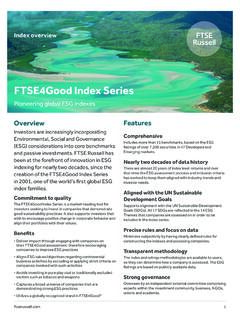
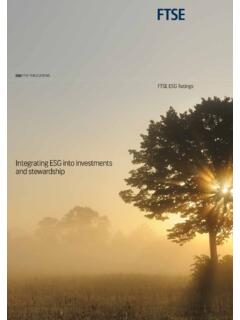
![Membership of the [Committee Name]](/cache/preview/9/9/6/b/7/9/b/9/thumb-996b79b98db3a1f1de093b5160b5ea4d.jpg)



